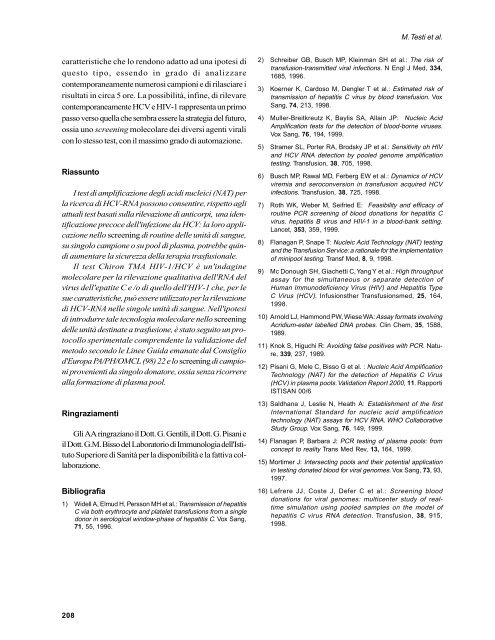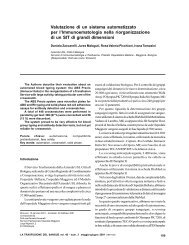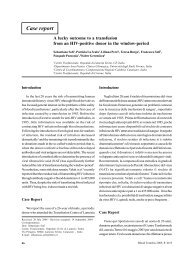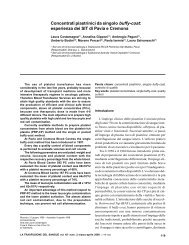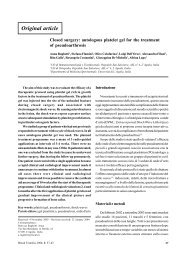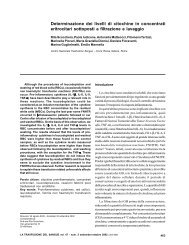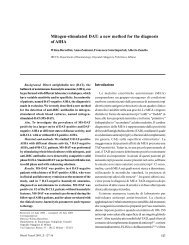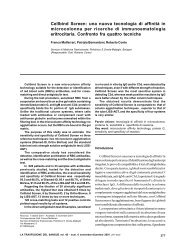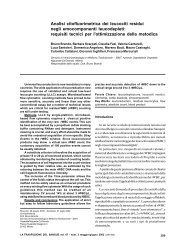Il test Chiron-TMA: un approccio molecolare allo ... - Blood Transfusion
Il test Chiron-TMA: un approccio molecolare allo ... - Blood Transfusion
Il test Chiron-TMA: un approccio molecolare allo ... - Blood Transfusion
Create successful ePaper yourself
Turn your PDF publications into a flip-book with our unique Google optimized e-Paper software.
M. Testi et al.caratteristiche che lo rendono adatto ad <strong>un</strong>a ipotesi diquesto tipo, essendo in grado di analizzarecontemporaneamente numerosi campioni e di rilasciare irisultati in circa 5 ore. La possibilità, infine, di rilevarecontemporaneamente HCV e HIV-1 rappresenta <strong>un</strong> primopasso verso quella che sembra essere la strategia del futuro,ossia <strong>un</strong>o screening <strong>molecolare</strong> dei diversi agenti viralicon lo stesso <strong>test</strong>, con il massimo grado di automazione.Riass<strong>un</strong>toI <strong>test</strong> di amplificazione degli acidi nucleici (NAT) perla ricerca di HCV-RNA possono consentire, rispetto agliattuali <strong>test</strong> basati sulla rilevazione di anticorpi, <strong>un</strong>a identificazioneprecoce dell'infezione da HCV: la loro applicazionenello screening di routine delle <strong>un</strong>ità di sangue,su singolo campione o su pool di plasma, potrebbe quindiaumentare la sicurezza della terapia trasfusionale.<strong>Il</strong> <strong>test</strong> <strong>Chiron</strong> <strong>TMA</strong> HIV-1/HCV è <strong>un</strong>'indagine<strong>molecolare</strong> per la rilevazione qualitativa dell'RNA delvirus dell'epatite C e /o di quello dell'HIV-1 che, per lesue caratteristiche, può essere utilizzato per la rilevazionedi HCV-RNA nelle singole <strong>un</strong>ità di sangue. Nell'ipotesidi introdurre tale tecnologia <strong>molecolare</strong> nello screeningdelle <strong>un</strong>ità destinate a trasfusione, è stato seguito <strong>un</strong> protocollosperimentale comprendente la validazione delmetodo secondo le Linee Guida emanate dal Consigliod'Europa PA/PH/OMCL (98) 22 e lo screening di campioniprovenienti da singolo donatore, ossia senza ricorrerealla formazione di plasma pool.RingraziamentiGli AA ringraziano il Dott. G. Gentili, il Dott. G. Pisani eil Dott. G.M. Bisso del Laboratorio di Imm<strong>un</strong>ologia dell'IstitutoSuperiore di Sanità per la disponibilità e la fattiva collaborazione.Bibliografia1) Widell A, Elmud H, Persson MH et al.: Transmission of hepatitisC via both erythrocyte and platelet transfusions from a singledonor in serological window-phase of hepatitis C. Vox Sang,71, 55, 1996.2) Schreiber GB, Busch MP, Kleinman SH et al.: The risk oftransfusion-transmitted viral infections. N Engl J Med, 334,1685, 1996.3) Koerner K, Cardoso M, Dengler T et al.: Estimated risk oftransmission of hepatitis C virus by blood transfusion. VoxSang, 74, 213, 1998.4) Muller-Breitkreutz K, Baylis SA, Allain JP: Nucleic AcidAmplification <strong>test</strong>s for the detection of blood-borne viruses.Vox Sang, 76, 194, 1999.5) Stramer SL, Porter RA, Brodsky JP et al.: Sensitivity oh HIVand HCV RNA detection by pooled genome amplification<strong>test</strong>ing. <strong>Transfusion</strong>, 38, 705, 1998.6) Busch MP, Rawal MD, Ferberg EW et al.: Dynamics of HCVviremia and seroconversion in transfusion acquired HCVinfections. <strong>Transfusion</strong>, 38, 725, 1998.7) Roth WK, Weber M, Seifried E: Feasibility and efficacy ofroutine PCR screening of blood donations for hepatitis Cvirus, hepatitis B virus and HIV-1 in a blood-bank setting.Lancet, 353, 359, 1999.8) Flanagan P, Snape T: Nucleic Acid Technology (NAT) <strong>test</strong>ingand the <strong>Transfusion</strong> Service: a rationale for the implementationof minipool <strong>test</strong>ing. Transf Med, 8, 9, 1998.9) Mc Donough SH, Giachetti C, Yang Y et al.: High throughputassay for the simultaneous or separate detection ofHuman Imm<strong>un</strong>odeficiency Virus (HIV) and Hepatitis TypeC Virus (HCV). Infusionsther <strong>Transfusion</strong>smed, 25, 164,1998.10) Arnold LJ, Hammond PW, Wiese WA: Assay formats involvingAcridium-ester labelled DNA probes. Clin Chem, 35, 1588,1989.11) Knok S, Higuchi R: Avoiding false positives with PCR. Nature,339, 237, 1989.12) Pisani G, Mele C, Bisso G et al. : Nucleic Acid AmplificationTechnology (NAT) for the detection of Hepatitis C Virus(HCV) in plasma pools. Validation Report 2000, 11. RapportiISTISAN 00/613) Saldhana J, Leslie N, Heath A: Establishment of the firstInternational Standard for nucleic acid amplificationtechnology (NAT) assays for HCV RNA. WHO CollaborativeStudy Group. Vox Sang, 76, 149, 1999.14) Flanagan P, Barbara J: PCR <strong>test</strong>ing of plasma pools: fromconcept to reality Trans Med Rev, 13, 164, 1999.15) Mortimer J: Intersecting pools and their potential applicationin <strong>test</strong>ing donated blood for viral genomes. Vox Sang, 73, 93,1997.16) Lefrere JJ, Coste J, Defer C et al.: Screening blooddonations for viral genomes: multicenter study of realtimesimulation using pooled samples on the model ofhepatitis C virus RNA detection. <strong>Transfusion</strong>, 38, 915,1998.208


